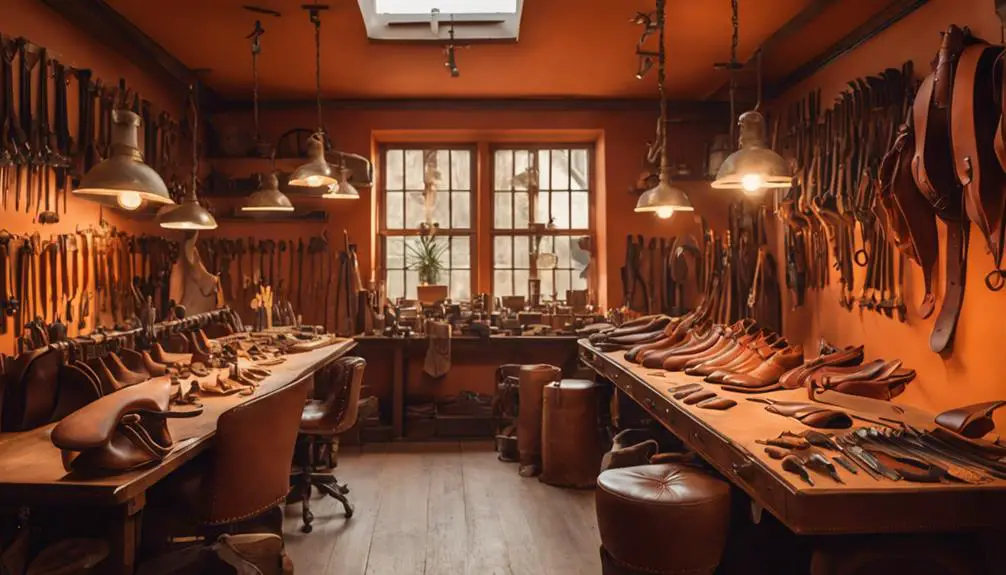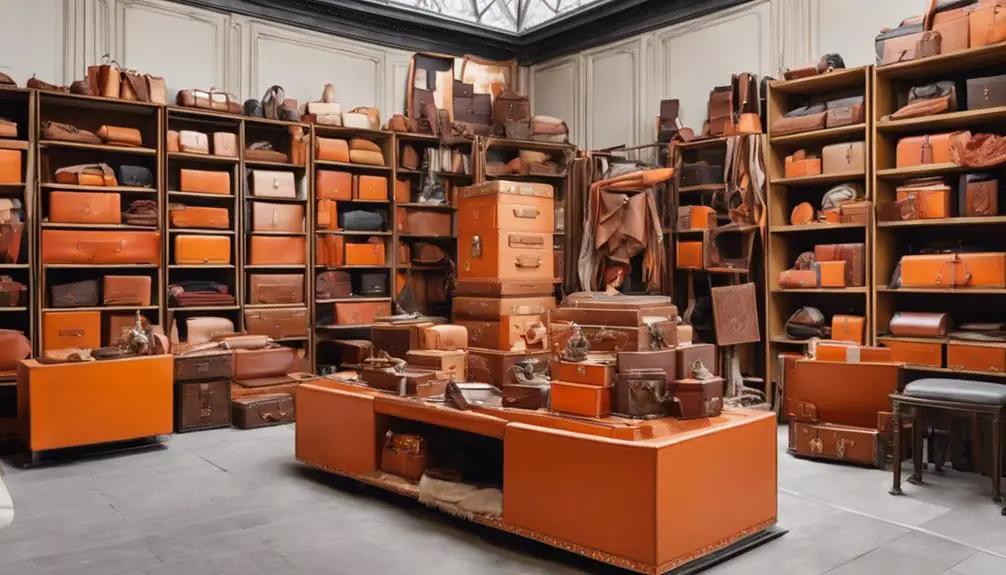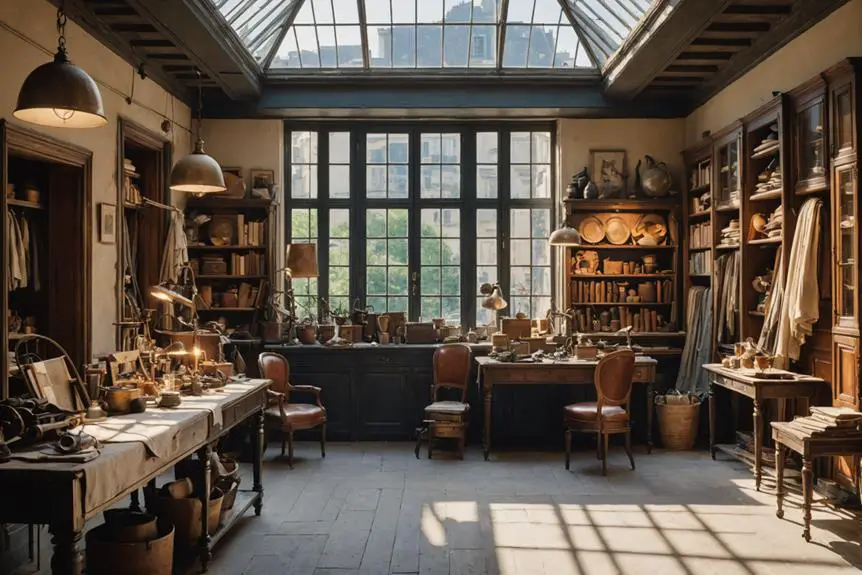The House of Hermès, founded in 1837 by Thierry Hermès in Paris, started as a workshop for crafting high-quality harnesses and bridles for the elite. Gaining fame at the Expositions Universelles in 1855 and 1867, it quickly made a name in custom saddlery. After moving to 24 Rue Faubourg Saint-Honoré, Thierry's grandsons shifted focus to luxurious leather goods. The introduction of the Haut-à-Courroies bag in 1900 marked Hermès' entry into handbags, leading to iconic designs like the Kelly and Birkin bags. This remarkable journey reflects a commitment to excellence that's still alive today—there's plenty more to explore about this legendary brand.
Origins of Hermès

The origins of Hermès trace back to 1837 when Thierry Hermès founded the brand in Paris, primarily crafting high-quality harnesses and bridles for the French nobility. His commitment to craftsmanship quickly gained recognition, winning first prizes at the Expositions Universelles in 1855 and 1867 for technical achievements in harness making. This not only highlighted his skill but also set the stage for what would become a legendary brand.
After a street demolition, Thierry relocated his workshops to 24 Rue Faubourg Saint-Honoré, further enhancing Hermès' reputation for excellence in custom saddlery. Following Thierry's death in 1878, his grandsons, Charles-Émile and Émile-Maurice Hermès, took the reins. They skillfully shifted the company's focus toward luxury leather goods, expanding its clientele beyond the French elite.
In 1900, Hermès made its first foray into handbag design with the introduction of the Haut-à-Courroies bag. This innovative step laid the groundwork for the creation of iconic products, including the famed Birkin and Kelly bags. These bags have become synonymous with luxury, embodying the essence of Hermès' dedication to quality and style.
As you explore the early days of Hermès, you'll appreciate how Thierry Hermès' vision and the craftsmanship of his successors shaped a legacy that continues to thrive in the world of luxury today.
Evolution of Luxury Handbags
Exploring the evolution of luxury handbags at Hermès reveals a fascinating journey marked by innovation and timeless elegance. It all began in 1900 with the launch of the Haut à Courroies, a bag designed for carrying saddles. This initial design laid the groundwork for future luxury handbags, showcasing the brand's commitment to quality and functionality.
In 1922, Hermès introduced its first leather handbag with a patented zipper, enhancing the practicality of luxury accessories. This focus on innovation continued with the iconic Kelly bag, which gained fame in 1956 when Grace Kelly was photographed using it. Suddenly, this bag wasn't just a handbag; it became a symbol of elegance and luxury.
Fast forward to 1984, when Hermès created the Birkin bag for actress Jane Birkin. This bag quickly became one of the most sought-after handbags in the world, renowned for its exclusivity and masterful craftsmanship. Each Birkin bag is crafted through artisanal production, guaranteeing that every piece is unique and upholds the brand's luxurious standards.
Thierry Hermès' vision of quality and exclusivity remains at the heart of Hermès today. The brand maintains exclusive rights to its designs, refusing to engage in mass production.
This dedication to artisanal craftsmanship not only preserves the luxury status of Hermès handbags but also guarantees that each piece tells a story of tradition and evolution, reflecting the exquisite journey of luxury handbags through the decades.
Iconic Products and Milestones
Hermès has become synonymous with iconic products that define luxury and craftsmanship. From silk scarves to leather handbags, each item tells a story of elegance and quality. You mightn't know that Hermès began its journey in 1937 with the launch of its first silk scarf, designed by Robert Dumas. Today, the brand boasts over 2,000 unique designs, showcasing its commitment to creativity.
Here are some key milestones in Hermès' illustrious history:
- 1922: Introduction of the first leather handbag with a patented zipper, revolutionizing the way handbags were made.
- 1951: Launch of Eau d'Hermès, marking the brand's entry into luxury fragrance, further diversifying its offerings.
- 1956: The iconic Kelly bag made its debut, becoming a symbol of elegance after being spotted on actress Grace Kelly.
- 1984: The Birkin bag was created following a conversation between Jean-Louis Dumas and actress Jane Birkin, quickly becoming the epitome of exclusivity in luxury fashion.
These iconic products not only reflect Hermès' dedication to craftsmanship but also its ability to evolve while maintaining its heritage. Each piece, whether it's a silk scarf or a Birkin bag, represents a commitment to quality that continues to captivate fashion enthusiasts worldwide.
Hermès remains a beacon of luxury, with a legacy that stands the test of time.
Leadership and Strategic Growth
Throughout its history, Hermès has consistently demonstrated strong leadership and strategic growth, adapting to the ever-changing luxury market. Founded by Thierry Hermès in 1837, the company started with high-quality harnesses for the French nobility. After Thierry's death in 1878, his grandsons took over, ensuring the brand's commitment to excellence.
In 1978, Jean-Louis Dumas stepped in, fundamentally transforming Hermès. His vision led to the expansion into new product lines, solidifying the brand's position in the luxury market. Under his leadership, iconic products like the Kelly bag emerged, capturing the hearts of customers worldwide. The perfume division, launched in 1961, further showcased the brand's commitment to innovation.
Axel Dumas, a sixth-generation member of the Hermès family, took the reins as Executive Chairman in 2013. He continued the legacy of strategic growth, driving the company into new markets. During the 2000s, Hermès underwent significant international expansion, opening new stores in key locations. This move not only increased brand presence but also allowed more customers to experience their luxurious offerings.
Throughout these leadership changes, the Hermès family has remained at the core of the brand's identity. Their dedication to quality and craftsmanship has propelled Hermès forward, ensuring it remains a symbol of luxury worldwide.
With each new generation, the company embraces change while honoring its rich heritage, paving the way for a bright future.
Cultural Impact and Legacy

At the heart of luxury fashion, the House of Hermès has carved out a distinct cultural legacy that resonates with elegance and exclusivity. With its iconic products like the Birkin and Kelly bags, Hermès hasn't only set trends but also established a standard in the luxury market through unparalleled craftsmanship.
Each handbag is a representation of artisanal know-how, meticulously handcrafted by skilled artisans, ensuring that quality remains at the forefront of their legacy.
The cultural impact of Hermès extends beyond its products, thanks largely to high-profile endorsements. Princess Grace Kelly's association with the Kelly bag elevated the brand's status among elite circles, making it synonymous with sophistication.
Her influence helped define the allure of Hermès, transforming its handbags into coveted symbols of luxury.
Here are some key highlights of Hermès' cultural impact:
- Iconic Products: The Birkin and Kelly bags symbolize not just luxury, but an entire lifestyle.
- Artistic Endeavors: Through the Fondation d'entreprise Hermès, the brand promotes contemporary art and culture.
- Commitment to Craftsmanship: Each piece represents a legacy of artisanal skills passed down through generations.
- Market Presence: Ranking 7th in WIPO's industrial design registrations showcases the brand's influence.
Hermès continues to shape the luxury landscape while honoring its commitment to quality and cultural enrichment, ensuring its legacy endures for generations to come.




